Disclosure: Privacy Australia is community-supported. We may earn a commission when you buy a VPN through one of our links. Learn more.
Top 10 Brokers for Short Selling in 2024 with 2 Notable Mentions
We all want to make a profit when we choose to invest and trade. It’s the key reason in the first place. To be able to do that, we need to know some advanced strategies to enhance our chances of success. One of those strategies is short selling.
In any type of trade, profits are made if the market moves up. However, in short selling, we speculate on a declining stock or other type of security. The idea is that we’re going against the market and selling shares that we don’t actually own. In the meantime, interest grows on the borrowed shares (loan). Then, we hope that a reduction in price will be enough that it leaves plenty of profits after the loan closes.
This type of speculation is a strategy often used by portfolio managers or investors to manage risk against market slumps. Of course, it’s risky but that’s how profits are generally made.
TL;DR
- Pepperstone: Best for retail forex and CFD trading, with strong regulatory oversight.
- AvaTrade: Best for beginner and advanced traders with various platforms available.
- Interactive Brokers: Best for active and global traders, with low commissions for high-volume traders.
- Moomoo: Best for cost-conscious traders with intuitive platforms and no commission on U.S. stocks or ETFs.
- TradeZero: Best overall brokerage for short selling with low costs and user-friendly interface.
- Cobra Trading: Best for short selling over $25k with exceptional customer support and expertise.
- TradeStation: Best for intermediate traders with comprehensive tools and educational resources.
- CenterPoint Securities: Best for premium short selling with advanced order routing.
- Webull: Best for active traders with commission-free trading and user-friendly interface.
- Guardian Trading: Best for day traders and scalpers with quick execution and competitive fees.
Criteria Breakdown Summary
When we’re looking at the best short selling brokers, we need to put together some criteria to measure them by. In this case, we chose:
- Availability of Shortable Stocks: The number and variety of stocks available for short selling.
- Commissions and Fees: Costs associated with short selling, including commissions, margin rates, and other hidden fees.
- Trading Tools and Resources: The availability of advanced trading tools, research, and educational resources.
- Platform Usability: Ease of use of the trading platform and the quality of customer support.
- Account Requirements: Minimum account balance requirements for short selling.
- Regulatory Compliance and Safety: The regulatory status of the broker and the safety measures they have in place.
These criteria will help us find the best short selling brokers and separate them from the rest.
Pepperstone
Best Known for Retail Forex and CFD Trading
Pepperstone is a solid name in the trading world, for many good reasons. It’s known for tight spreads, fast execution and user-friendly platforms. It’s a great choice for forex and CFD traders. It doesn’t cater specifically to short sellers but it allows it, thanks to its competitive pricing and global access market. It is also on the Australian Securities Exchange (ASX).
The only downside is that it lacks the range of shortable stocks we might find with specialised brokers. For more on this broker, check out our Pepperstone review.

Pepperstone is one of the largest brokers with a range of features.
Features
As one of the most popular brokers, it’s no surprise Pepperstone has many features. Alongside industry-standard MetaTrader 4 & 5 platforms, there is also cTrader and a mobile app. These platforms offer charting tools, fast speeds, and automated trading. Additionally, there are countless forex pairs, alongside CFDs, commodities, indices, and cryptocurrencies.
This is one of the brokers that allow short selling, but it’s not a dedicated option.
Pros
Tight spreads and fast execution
Multiple trading platforms
Comprehensive range of forex pairs and CFDs
Cons
Limited stock trading options
Allows short selling, but not ideal for dedicated short sellers
Criteria Evaluation
Availability of Shortable Stocks: 2/5
Commissions and Fees: 4/5
Trading Tools and Resources: 3/5
Platform Usability: 4/5
Account Requirements: 4/5
Regulatory Compliance and Safety: 5/5
Community Reviews and Expert Recommendations
Pepperstone receives mostly positive reviews for its trading environment. Users particularly rate its fast speeds and tight spreads. However, it’s not the most favoured option for those looking at how to short sell because of the limited options. So, while it’s possible, it’s not the best choice. Experts concur with this, praising Pepperstone for its strong regulation and features.
Price
This broker offers competitive spreads that start at 0.0 pips. Commission fees depend on account type. For instance, there are commission charges on the Razor account. Regardless, the pricing structure is easy to understand and transparent.
AvaTrade
Best Known for Accessible Forex and CFD Trading
AvaTrade is another instantly recognisable name and one that has many happy customers. The site is very easy to use and it’s a great choice for beginners in particular. This broker offers many tradable instruments, including forex pairs, cryptocurrency, and CFDs.
Again, this isn’t a dedicated short selling platform but it is allowed and possible. Additionally, it is available through the Australian Securities Exchange.There are also many features that work for all types of trading, including those who want to short a stock. You can learn more in our AvaTrade review.
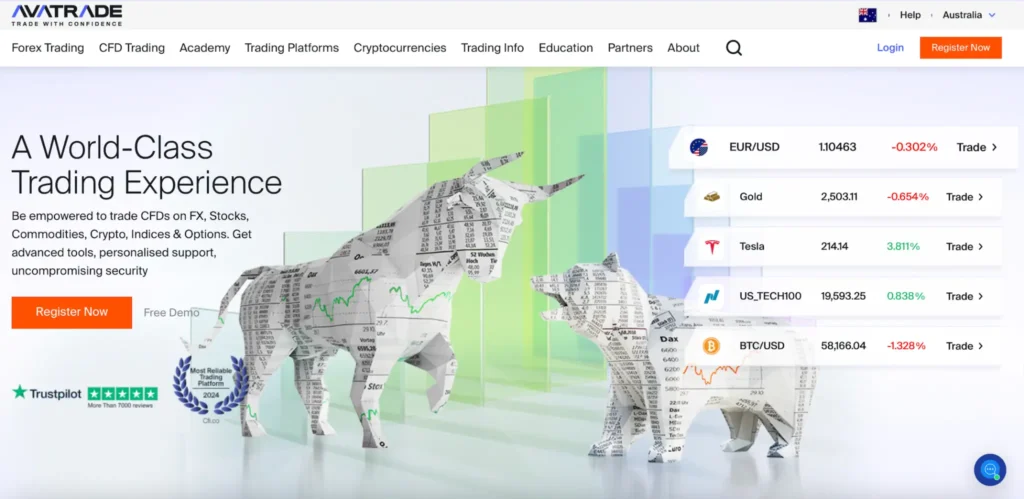
AvaTrade is a popular broker with a range of tradable instruments.
Features
As with all major brokers, AvaTrade offers a range of platforms. This includes MetaTrader 4 & 5 and its own platform AvaTradeGO. All platforms are easy to use and offer social trading options. The app enables on-the-go trading. Moreover, AvaTrader offers a range of educational resources and tools for market analysis. As a result, it’s ideal for all types of traders, including beginners.
However, while it does offer shortable stocks, the options are limited, as with our previous broker.
Pros
User-friendly platforms
Wide range of educational resources
Competitive spreads on forex and CFD
Cons
Limited options for shorting stocks
Withdrawal fees on some methods
Criteria Evaluation
Availability of Shortable Stocks: 2/5
Commissions and Fees: 4/5
Trading Tools and Resources: 3/5
Platform Usability: 4/5
Account Requirements: 4/5
Regulatory Compliance and Safety: 5/5
Community Reviews and Expert Recommendations
AvaTrade receives high praise from users, thanks to the number of educational resources on offer. It’s also said to be a very easy to use option, enjoyed particularly by new traders. However, many traders who want to try short selling mention that it has a limited availability of shortable stocks.
Experts agree with this feedback, highlighting its intuitive interface and ease of use.
Price
AvaTrade is a cost-effective choice, with competitive spreads on CFDs and forex. There are no commission fees with the Standard account, however there are with more advanced account types. For this reason, it’s important to assess account types before making a choice. The good news is that this broker is very transparent about fees, but there are some charges for certain withdrawals.
Interactive Brokers
Best Known for Active and Global Traders
For traders who want to focus on short stocks, Interactive Brokers is an ideal choice. It has a large range available and offers low commissions for high-volume traders. It also offers many advanced trading tools for analysis, alongside access to the global market.
Interactive Brokers is a particularly good choice for active and professional traders. While beginners certainly can try this platform, it is a little complex from the get-go, so it may be the best option. As with our other choices so far, this broker is also available through the Australian Securities Exchange.
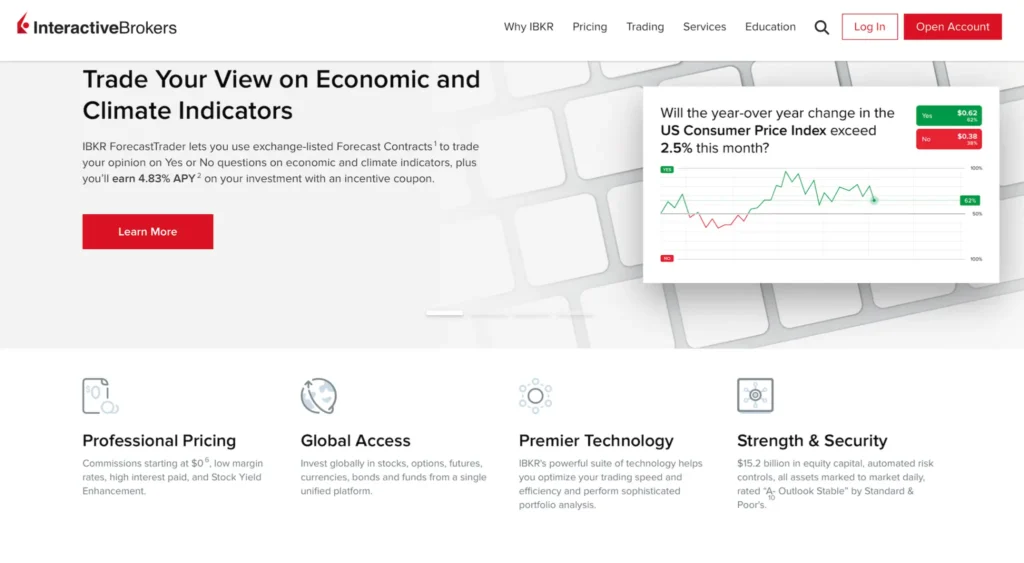
Interactive Brokers is a good choice for high-volume traders, with a large range of tools.
Features
The biggest advantage to choosing Interactive Brokers is its large range of advanced trading tools. This includes the IBKR Securities Loan Borrow System, and it also provides access to global markets.
Again, this platform is likely to be too complex for new traders but advanced traders will enjoy the range of features. This platform is particularly known for its large short inventory and it also has low per-share pricing. Overall, it’s one of the best brokers for shorting stocks.
Pros
Extensive short inventory
Low per-share pricing
Advanced trading tools
Cons
Complex platform for beginners
$10,000 minimum for earning interest
Criteria Evaluation
Availability of Shortable Stocks: 5/5
Commissions and Fees: 4/5
Trading Tools and Resources: 5/5
Platform Usability: 3/5
Account Requirements: 3/5
Regulatory Compliance and Safety: 5/5
Community Reviews and Expert Recommendations
Traders who want to focus on short selling rate Interactive Brokers quite high. The range of stocks offered is a particular highlight. The number of advanced trading tools are also frequently mentioned. However, most state that it’s not the most beginner-friendly platform around. Experts also agree with this, recommending this broker for high-volume traders in particular.
Price
For those who want to learn how to short sell, the prices for this broker are reasonable. With a competitive structure, fees range from $0.0005 to $0.0035 per share, but the exact amount depends on volume.
Moomoo
Best Known for Cost-conscious Traders
We all want to keep our trading costs low, and in that case, Moomoo is a broker to consider. With no commission charges on US stocks or ETFs, this broker also offers long trading hours. Overall, it makes the whole experience much easier. On top of that, the platform is very easy to use and intuitive, so it’s a good choice for beginners.
The biggest downside is that this broker doesn’t support cryptocurrencies. It does allow traders to short sell, although it’s not a dedicated broker. Again, it is available for the Australian Securities Exchange (ASX).
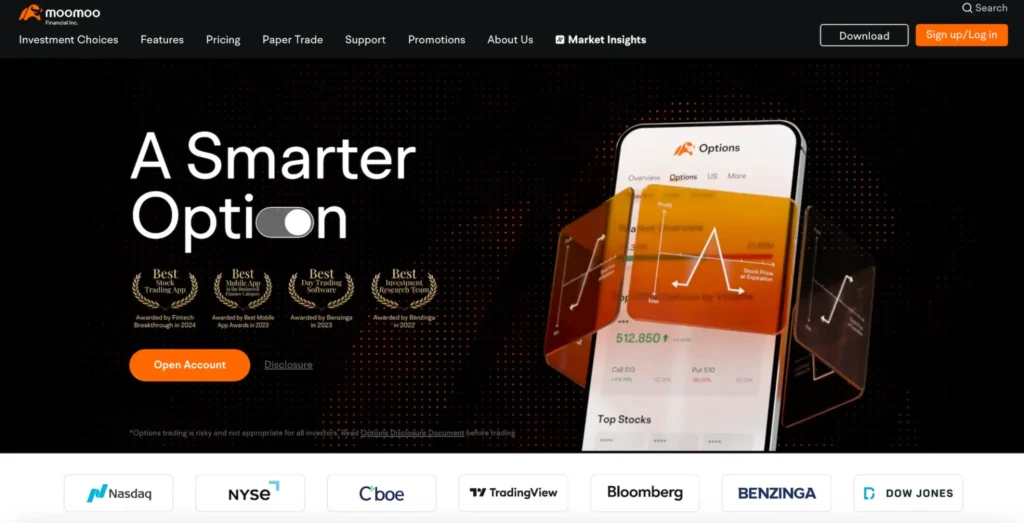
Moomoo offers a cost effective environment for all traders.
Features
Considering its low trading fees, Moomoo offers many features. These include real-time Level 2 data, extended trading hours, and advanced charting tools. Beginner and advanced traders won’t struggle with this platform, which is easy to use and intuitive. As mentioned, low fees also add to the positives.
It is possible to short stocks with this broker, but it’s not a dedication option.
Pros
No commission on U.S. stocks or ETFs
Intuitive platform
Cons
No support for crypto or retirement accounts
Criteria Evaluation
Availability of Shortable Stocks: 3/5
Commissions and Fees: 4/5
Trading Tools and Resources: 4/5
Platform Usability: 4/5
Account Requirements: 4/5
Regulatory Compliance and Safety: 3/5
Community Reviews and Expert Recommendations
Overall, Moomoo receives positive comments from users and industry experts. Most mention its low fees and easy-to-use interface. However, some users mention that they would like the option for crypto trading, which Moomoo doesn’t have.
Industry experts mention that Moomoo is a good option for beginner traders and for those who want to keep costs low. They also acknowledge that while shorting a stock is possible through this broker, it’s not a dedicated option.
Price
Moomoo offers commission-free trading on US stocks and ETFs.
TradeZero
Best Overall Brokerage for Short Selling
TradeZero is one of the best brokers for short selling because its platform is tailored specifically to that aim. It has low costs and a very user-friendly interface. It’s a great choice for active traders and not too complex for beginners.
The downside is that US residents have to use the TradeZero America version due to regulatory restrictions. Additionally, this broker isn’t available on the Australian Securities Exchange (ASX).
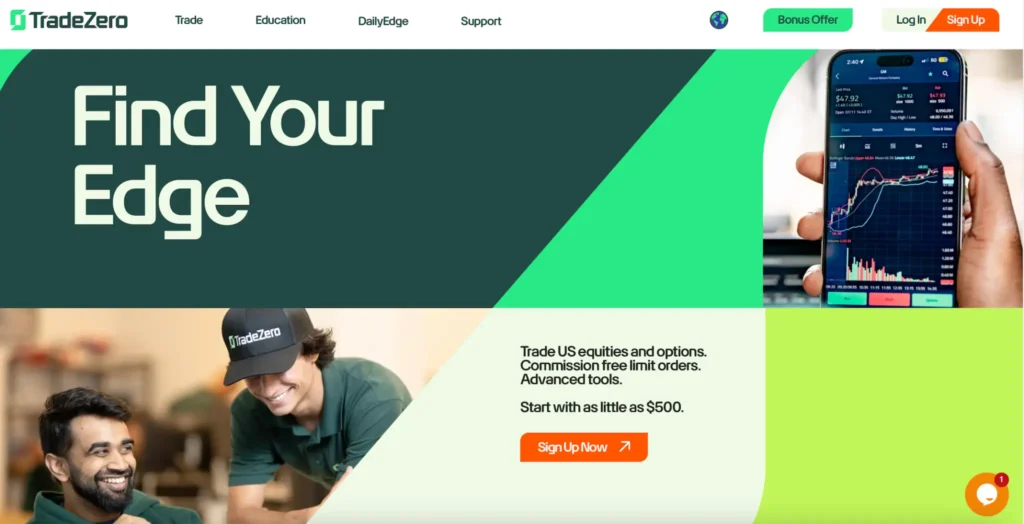
TradeZero is a quality short selling broker with several useful features.
Features
TradeZero makes it easy to short sell, with free limit orders, 6:1 intraday leverage, and marketable orders. The platform itself is designed for active traders but it’s so easy to use that beginners can find their way around.
With low costs and plenty of features, this is an ideal choice for those who are interested in short selling in particular.
Pros
Low costs
User-friendly interface
Cons
Changing leverage options can be confusing
Criteria Evaluation
Availability of Shortable Stocks: 4/5
Commissions and Fees: 3/5
Trading Tools and Resources: 4/5
Platform Usability: 4/5
Account Requirements: 3/5
Regulatory Compliance and Safety: 3/5
Community Reviews and Expert Recommendations
Most users praise TradeZero for its low costs and easy to use platform. Many agree that it’s best for active traders but doesn’t totally alienate beginners who want to explore shorting stocks. However, it’s important to note that US residents do have to use the American version due to regulatory restrictions.
Experts agree that TradeZero is an ideal choice for its low costs and many short selling options.
Price
TradeZero’s pricing ranges from $0.0005 to $0.0035 per share depending on volume.
Cobra Trading
Best for Short Selling Over $25k
While not the best choice for beginners, Cobra Trading is a good option for high-volume traders. It’s best suited for those who want to short sell over $25,000. It also has easy access to borrows and also direct access routing. High stakes means a requirement for good access to customer support and I found that to be exceptional with this broker.
The biggest downside is high fees and the requirement for high minimum account balances. For that reason, it’s not a good choice for less experienced traders. However, high-volume traders who want to short stocks will find this a very useful platform. As a side note, it isn’t available for the Australian Securities Exchange (ASX).
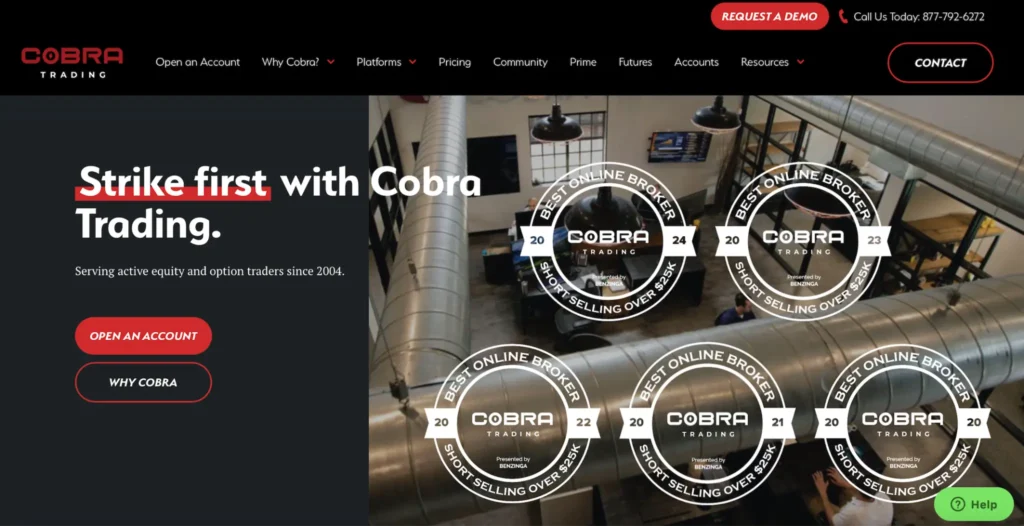
Cobra Trading is a good short selling broker for high-volume traders.
Features
Cobra Trading offers a range of features for high-volume traders, although it does lack educational resources. That’s probably because they expect their traders to already know the tricks, making it less useful for beginners. It offers a 33% discount on equity commissions and free trading software for a month.
This broker has exceptional customer support, on hand to help with any issues that arise. It is an ideal platform for short selling, although fees are a little higher than some other brokers.
Pros
Excellent customer support
High expertise
Cons
Higher minimum account balance
Pricier platform
Criteria Evaluation
Availability of Shortable Stocks: 5/5
Commissions and Fees: 3/5
Trading Tools and Resources: 4/5
Platform Usability: 3/5
Account Requirements: 2/5
Regulatory Compliance and Safety: 3/5
Community Reviews and Expert Recommendations
Users state that Cobra Trading’s customer support is excellent and offers advice and help quickly and effectively. However, many do dislike the high minimum account balances, which often puts some users off. Experts recommend Cobra Trading for advanced traders with large accounts, and don’t believe it is a good fit for beginners or even intermediate traders.
Price
Cobra Trading’s pricing ranges from $0.0015 to $0.003 per share depending on volume.
TradeStation
Best for Intermediate Traders
TradeStation is a great choice of broker for intermediate and advanced traders, but I wouldn’t recommend it for beginners. The tools are quite advanced and new traders will probably find them rather overwhelming.
However, for those who have some knowledge and want to learn about short selling, this broker offers many tools and educational resources. One downside is that this broker isn’t available for the Australian Securities Exchange (ASX).
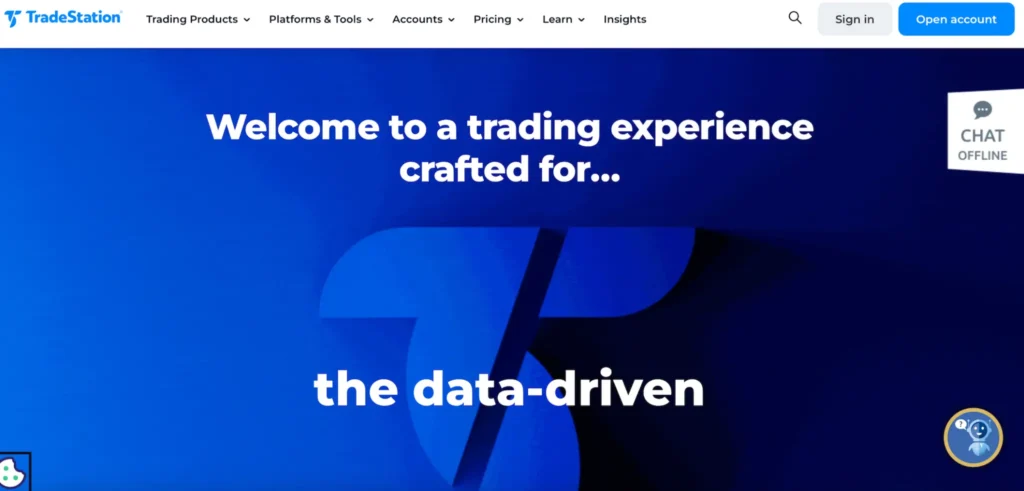
TradeStation is a quality platform for intermediate and advanced traders.
Features
As I mentioned, TradeStation offers a range of advanced trading tools, including professional-grade stock screeners. The TS GO account provides access to many of these tools plus a huge range of educational resources for further learning.
This is a good choice of broker for short stocks, and for anyone who wants to boost their trading skills.
Pros
Advanced trading tools
Extensive educational resources
Cons
Can be overwhelming for beginners
High monthly fees
Criteria Evaluation
Availability of Shortable Stocks: 4/5
Commissions and Fees: 4/5
Trading Tools and Resources: 4/5
Platform Usability: 4/5
Account Requirements: 3/5
Regulatory Compliance and Safety: 4/5
Community Reviews and Expert Recommendations
Many users rate TradeStation for its advanced tools and educational resources. However, as expected, many beginners who have tried the platform find it confusing and complex. It’s also an expensive choice, so it’s best for those who are serious about trading.
As one of the best brokers for short selling, experts also concur with what users say. They particularly rate it for advanced traders.
Price
TradeStation’s pricing ranges from $99 to $199 per month depending on services.
CenterPoint Securities
Best for Premium Short Selling
I recommend CenterPoint Securities for anyone who wants to short sell. It’s got a huge inventory of shortable stocks and advanced order routing. As a result, it’s best for high-volume traders, and I wouldn’t recommend it for beginners. The range of features are simply too complex for those who are just starting out. However, anyone who needs quick order processing will enjoy this platform.
The biggest downside is the high monthly fees and minimum account balance. This broker isn’t available for the Australian Securities Exchange.
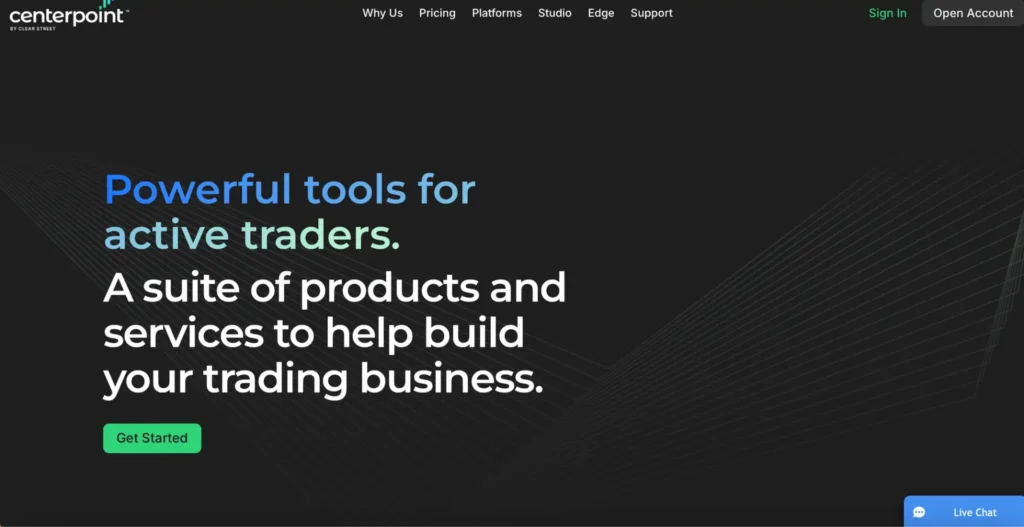
CenterPoint Securities is one of the best brokers for short selling.
Features
CenterPoint Securities is a one-stop-shop for everything to do with short selling. It’s ideal for advanced and high-volume traders and has an in-house securities lending team and advanced trading tools.
Execution speeds are extremely fast and the huge inventory of shortable stocks makes it one of the best in the market. There are also several platforms to choose from and many educational resources on offer.
Pros
Excellent for high-volume traders
Quick order processing
Cons
High monthly fees
High minimum account balance
Criteria Evaluation
Availability of Shortable Stocks: 5/5
Commissions and Fees: 3/5
Trading Tools and Resources: 5/5
Platform Usability: 3/5
Account Requirements: 2/5
Regulatory Compliance and Safety: 3/5
Community Reviews and Expert Recommendations
Many users rate CenterPoint Securities very highly for short selling. Most mention its fast speeds and huge inventory, but also its excellent customer service. However, many users mention the high fees associated with this broker and high account minimums. This can be off-putting for some.
Industry experts also rate this broker for short selling but mention that it isn’t an option for less experienced traders.
Price
CenterPoint Securities charges $138 monthly for the Pro Platform.
Webull
Best for Active Traders
We all live busy lives these days, so it’s useful when the sites and platforms we need are also available in mobile form. Webull is one of those. This is an app-based broker with a very easy to use interface and many features. As far as cost-effectiveness goes, this is a good option with commission-free trading depending on the account.
Webull is a good option for active traders who want to learn and develop, while also trying short selling. However, professional traders may find the number of advanced tools lacking. Additionally, this broker isn’t available for the Australian Securities Exchange (ASX).
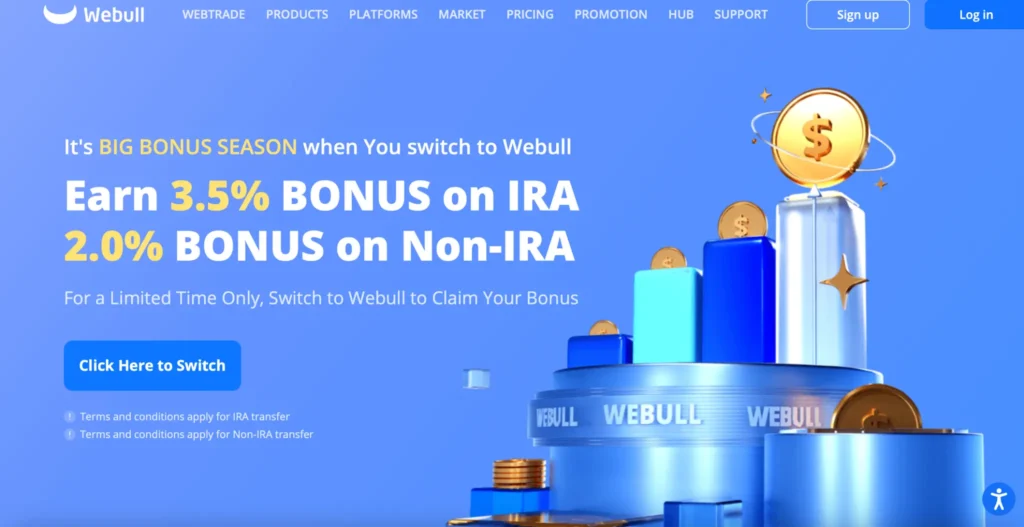
Webull is a great short selling broker for active traders looking for low trading fees.
Features
I mentioned cost-effectiveness and that’s certainly one of Webull’s main features. It offers commission-free trading alongside an easy to use interface. There are also many educational resources for beginners in particular, making it easy to learn about short selling and more.
This broker is a great choice for beginners and active traders, thanks to its simplicity. However, as previously mentioned, advanced traders may not get enough out of it.
Pros
Low fees
Extensive educational resources
Cons
Limited range of tools
Not ideal for high-volume traders
Criteria Evaluation
Availability of Shortable Stocks: 3/5
Commissions and Fees: 5/5
Trading Tools and Resources: 4/5
Platform Usability: 5/5
Account Requirements: 5/5
Regulatory Compliance and Safety: 4/5
Community Reviews and Expert Recommendations
Many users enjoy Webulls for its commission-free trading environment. This is one of the most mentioned aspects of this broker. However, the easy to use interface is another common mention, alongside its educational resources. Industry experts recommend this broker for beginners and active traders, and for short selling.
Price
Webull offers commission-free trading.
Guardian Trading
Best for Day Traders and Scalpers
Fast speeds are one of the main features most of us look for, and Guardian Trading ticks that box. This broker is a great choice for intermediate and advanced day traders, and it also has competitive securities lending programs. However, I don’t believe it’s the best choice for beginners as the platform may be too complex to learn on the go.
It’s a great choice for those who want to try short selling and offers cost efficiency and speed. As with some of the others, this broker also isn’t available for the Australian Securities Exchange.
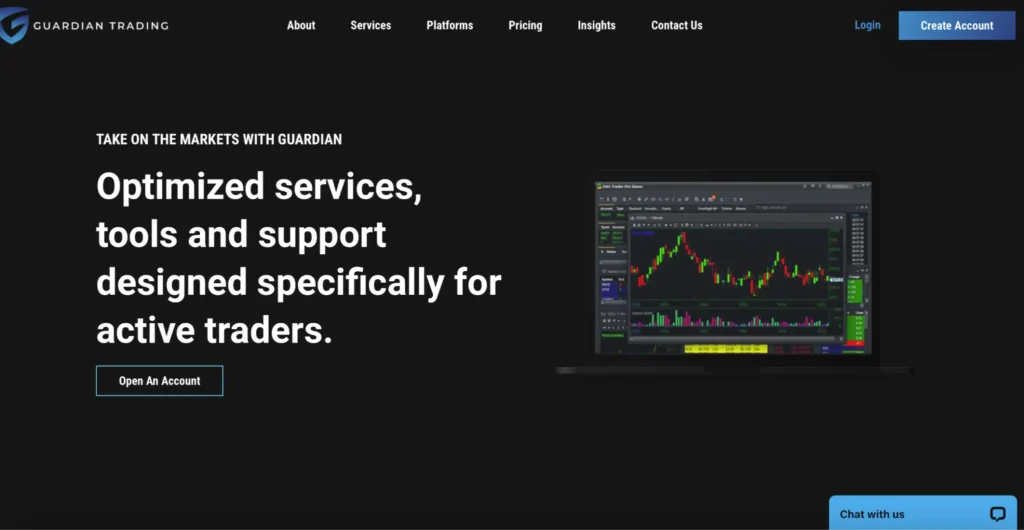
Guardian Trading is a great short selling broker for intermediate and advanced day traders.
Features
Guardian Trading is a prime option for short selling thanks to its real-time access and advanced features. It offers short locates and also overnight borrows. It is specifically designed for traders who know a little about what they’re doing. As before, it’s not ideal for new traders who are trying to learn. There are few educational resources and those are aimed toward traders with prior knowledge.
This broker offers fast execution speeds and very competitive fees. It has several different account types, and easy to use platforms.
Pros
Quick execution
Competitive securities lending programs
Cons
May be too complex for new traders
Criteria Evaluation
Availability of Shortable Stocks: 4/5
Commissions and Fees: 3/5
Trading Tools and Resources: 4/5
Platform Usability: 3/5
Account Requirements: 3/5
Regulatory Compliance and Safety: 3/5
Community Reviews and Expert Recommendations
Previous users rate Guardian Trading for its very fast execution speeds in particular. Another mentioned aspect is its competitive feeds and advanced trading tools. However, users also appreciate that it’s a complex platform that may not be ideal for new traders. Experts agree with all this and recommend it for advanced day traders in particular.
Price
Guardian Trading offers competitive fees.
Notable Mentions
eToro
eToro is an extremely popular broker with a range of features, including social trading. This allows us to copy the trades of successful investors and have a much better chance of success. With easy to use platforms and many tradable instruments, eToro isn’t specifically designed for short trading, but does allow it.
The downsides are that it comes with higher spreads and isn’t available for US investors. Read our eToro review for more information.
Charles Schwab
Charles Schwab is another notable alternative to the short selling brokers we’ve mentioned. It offers a large range of educational resources for learning and several trading platforms. It allows for short selling and has many portfolio management tools However, it does have higher rates than some of its competitors.
FAQ
What is short selling?
In essence, short selling is an advanced trading strategy. It allows an investor to borrow shares and then sell them, hoping to buy them back at a lower price. From that, they make a profit. It is a way to bet against a stock, and make money when the price of that stock falls. It’s important to learn how short selling works in detail before trying it for the first time. You can also check out our guide on the most shorted stocks on the ASX.
How do I short a stock?
To short a stock, an investor borrows shares from their brokers and sells them on the open market. Later, they buy back the same number of shares at a lower price. At least, that’s the plan. Then, they return them to the broker and keep the difference. Learning how to sell short properly reduces some of the risk. See our guide on how to short a stock for details.
What are the risks of short selling?
Shorting a stock does come with significant risks. These include high losses as it’s entirely possible that the stock price can rise by a large amount. If the price does increase, margin calls may come into the equation, meaning more funds need to be deposited.
Can I short stocks with a regular brokerage account?
No, in general you need a margin account to short stocks. A regular brokerage account doesn’t allow for short selling because it requires the borrowing of shares, therefore requiring margin.
Final Thoughts
Choosing the right broker for short selling is an important step. Making the wrong decision makes life much harder and impacts on trading success. Each of the brokers we’ve talked about have their own unique features and allow for short selling. However, some are more tailored to this strategy than others. That’s why it’s so important to do thorough research before making a final decision.
Let’s recap quickly:
- Pepperstone: Best for retail forex with strong regulatory oversight.
- AvaTrade: Best for beginner and advanced traders with many platforms on offer.
- Interactive Brokers: Best for active and global traders.
- Moomoo: Best for cost-conscious traders.
- TradeZero: Best overall brokerage for short selling.
- Cobra Trading: Best for short selling over $25k.
- TradeStation: Best for intermediate traders.
- CenterPoint Securities: Best for premium short selling.
- Webull: Best for active traders.
- Guardian Trading: Best for day traders and scalpers.
At Privacy Australia, we understand how confusing and overwhelming it can be to make the right broker decision. One wrong move could make life much harder than it should be.
Whether you need guidance on online privacy or choosing a broker, we have a range of reviews and insights to help.
After all, our mission is to give you as much information as possible. Then, you can move forward and stay safe online, while reaching toward profits.
You Might Also Like:





